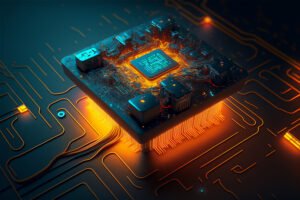The limits of connectivity and data transfer rates have continually been pushed by the development of wireless communication technology. Each generation of cellular networks has been a step towards more sophisticated and capable wireless networks, starting with the first generation (1G) cellular networks that allowed for simple voice communication and ending with the fifth generation (5G) networks that included ultra-fast data rates and minimal latency.
Sixth-generation (6G) technology, which will hopefully once again transform connectivity, is now on the horizon. Field-Programmable Gate Arrays (FPGAs), adaptable electrical components that are slated to play a crucial role in defining the following generation of wireless networks, are essential to the achievement of the ambitious targets of 6G.
Role of FPGAs in Next-Gen Wireless Networks
Particularly in the context of 6G technology, Field-Programmable Gate Arrays (FPGAs) have emerged as critical facilitators in the construction of next-generation wireless networks. These incredibly adaptable integrated circuits have special benefits that make them ideal for meeting the demands and difficulties brought on by the development of wireless communication. We shall enlarge on the relevance of FPGAs and their impact on the development of wireless networks in this part.
A. Introduction to FPGAs
Field-Programmable Gate Arrays are semiconductor devices that can be configured by the user to perform a wide range of digital functions. Unlike Application-Specific Integrated Circuits (ASICs), FPGAs are reprogrammable, which means that their functionality can be altered even after manufacturing. This programmability allows for rapid prototyping, iterative design, and customization, making them ideal for the dynamic and evolving landscape of 6G technology.
B. Versatility and Programmability
FPGAs are crucial for meeting the many demands of 6G networks because they provide an unmatched level of adaptability and programmability. Traditional hardware designs frequently require a significant amount of time and money to build and produce ASICs in order to accommodate new standards or functions. To handle new communication protocols, modulation schemes, and signal processing methods, FPGAs, on the other hand, may be instantly modified. In order to support a wide range of use cases, from ultra-reliable low-latency communications (URLLC) to huge Internet of Things (IoT) connections, 6G networks must be flexible.
C. Advantages of Using FPGAs in 6G
Rapid Prototyping and Experimentation: FPGAs allow network engineers and researchers to experiment with various network configurations and protocols in real time. This accelerates the development cycle and enables the testing of novel ideas without the need for lengthy hardware redesigns.
Custom Acceleration: The data-intensive nature of 6G applications, such as AI-driven edge computing and massive MIMO, demands high-performance processing capabilities. FPGAs can be tailored to accelerate specific tasks, such as AI inference, cryptography, and complex signal processing, resulting in enhanced overall network performance.
Real-Time Adaptation: 6G networks will operate in dynamic environments with varying channel conditions and traffic loads. FPGAs can dynamically adapt their processing to changing conditions, ensuring optimal performance and resource utilization.
Reduced Time-to-Market: The reconfigurability of FPGAs reduces the time required to bring new network features and services to market. This agility is crucial in meeting the ever-evolving demands of consumers and industries.
Power Efficiency: FPGAs can be optimized for energy efficiency by implementing power-saving techniques tailored to specific workloads. This is especially important in 6G networks, where devices are expected to operate on limited battery resources.
Future-Proofing: The long development cycle of wireless technologies necessitates future-proof solutions. FPGAs, with their ability to evolve alongside new standards, ensure that 6G networks can seamlessly transition to subsequent generations without major hardware overhauls.
Applications of FPGAs in 6G Technology
FPGAs (Field-Programmable Gate Arrays) play a pivotal role in shaping the capabilities of 6G technology by offering unparalleled flexibility, adaptability, and performance. The unique characteristics of FPGAs make them a perfect fit for addressing the intricate challenges that arise in next-generation wireless networks. In this section, we delve into the diverse applications of FPGAs within the context of 6G technology.
A. Massive MIMO (Multiple-Input, Multiple-Output) Systems:
Advanced Beamforming Techniques: The use of Massive MIMO systems, which include numerous antennas at both the transmitter and receiver ends, is one of the core components of 6G. Advanced beamforming algorithms that dynamically redirect signals toward particular users or directions work exceptionally well on FPGAs. FPGAs’ ability to be reconfigured enables real-time response to shifting channel circumstances, improving signal quality and coverage.
B. mmWave and THz Communication:
Signal Processing Challenges: In order to achieve the data rates anticipated for 6G networks, terahertz (THz) and millimeter-wave (mmWave) frequencies are essential. These frequencies do, however, provide particular difficulties for signal processing. To enable dependable communication in these difficult conditions, FPGAs provide the computational capacity necessary for effective modulation, demodulation, and error correction at these high frequencies.
C. Dynamic Spectrum Sharing and Cognitive Radio:
Spectrum Sensing: FPGAs are employed in dynamic spectrum-sharing scenarios where multiple users or services dynamically share available frequency bands. FPGAs enable real-time spectrum sensing, facilitating efficient spectrum utilization and preventing interference with other users.
Cognitive Radio Protocols: FPGAs play a critical role in implementing cognitive radio protocols, allowing devices to intelligently select and switch between available frequency bands based on real-time channel conditions and policy considerations.
D. AI and Machine Learning at the Edge:
Real-time Data Analysis: The low-latency requirements of 6G networks call for AI and machine learning to be deployed at the network edge. FPGAs provide the necessary acceleration for AI workloads, enabling rapid data analysis and decision-making without the latency associated with transmitting data to centralized servers.
Efficient Inference: FPGAs are particularly well-suited for implementing efficient AI inference engines, allowing devices to perform complex tasks such as image recognition, natural language processing, and anomaly detection in real time.
These applications showcase how FPGAs empower 6G technology to overcome technical challenges and achieve the ambitious goals set for the next-generation wireless networks. The ability of FPGAs to be reprogrammed and optimized for specific tasks gives 6G networks the adaptability needed to cater to diverse communication scenarios and demanding use cases.
FPGA Design Considerations for 6G
The development of 6G technology includes the use of FPGAs (Field-Programmable Gate Arrays), which opens up new opportunities and challenges. FPGAs’ effectiveness and efficiency in 6G networks are greatly influenced by the design factors that go into them. Here, we explore the critical issues that scientists and engineers must take into account when integrating FPGAs into the design of next-generation wireless networks.
A. Hardware/Software Co-design
The division of capabilities between hardware and software is one of the key factors to take into account while employing FPGAs in 6G technology. Due of FPGAs’ flexibility, computationally demanding jobs can be transferred to hardware while leaving more adaptable and dynamic duties to software. The total performance and power consumption of the system can be considerably impacted by careful evaluation of which components should be implemented in hardware vs software.
Real-time processing and dynamic resource allocation are crucial in 6G networks, thus finding the correct hardware and software balance is essential. Understanding the trade-offs between power consumption, latency requirements, and communication needs is necessary for efficient co-design. Improved system responsiveness, decreased latency, and increased energy economy can result from optimizing this balance.
B. Energy Efficiency and Power Management
Given the rising demand for faster data rates and the abundance of connected devices, energy efficiency is a key challenge in the development of 6G networks. The system can adjust its power consumption dependent on the workload thanks to the dynamic power scaling capabilities provided by FPGAs. This versatility allows the network to scale its resources as necessary, which is especially helpful in settings with fluctuating network loads.
In addition, FPGA-based power management approaches employ techniques like turning off inactive components or lowering clock frequencies during idle times. These methods help reduce heat dissipation issues and increase device longevity in addition to conserving energy. Leveraging FPGA-based power management is crucial as power efficiency becomes a crucial aspect in the 6G environment.
C. Security and Privacy
In wireless networks, security is always of utmost importance, and 6G is no different. Through hardware-based security features, FPGAs can significantly improve network security. These capabilities may include hardware components that are tamper-resistant, secure boot procedures, and cryptographic acceleration. Protection from dangers like data breaches, unauthorized access, and even physical attacks is possible with FPGA-based security systems.
FPGAs can also help with the network’s implementation of encryption and authentication protocols. FPGAs can improve the overall performance and responsiveness of the network while ensuring strong security measures are in place by outsourcing these security-intensive jobs to hardware.
Future Directions and Challenges
The integration of FPGAs in 6G technology opens up a realm of exciting possibilities, but it also comes with its own set of challenges and avenues for future exploration. As the wireless landscape continues to evolve, addressing these challenges and steering the future direction of FPGA-enabled 6G networks will be crucial for realizing the full potential of this technology.
A. Evolving FPGA Architectures and Capabilities for 6G
Higher Performance and Capacity: Improving FPGA performance and capacity is one of the main directions for 6G development. FPGAs will need to advance to enable higher clock frequencies, more logic elements, and improved memory designs as 6G networks need even greater computing power to handle huge data flow.
AI Acceleration: Future FPGAs will probably concentrate on optimal hardware designs for AI acceleration given the growing integration of AI and machine learning in wireless networks. To accelerate AI tasks while consuming the least amount of power, this entails integrating specialist AI-oriented processing units, such as dedicated tensor processing units (TPUs).
Reconfigurability and Adaptability: In 6G networks, the capacity to dynamically modify FPGA architectures in response to shifting network requirements would be crucial. Future FPGAs may include more dynamic reconfiguration features to accommodate changing communication standards, frequency ranges, and protocols.
B. Overcoming Limitations and Bottlenecks in FPGA-based Designs
Power Efficiency: Even though they can be programmed, FPGAs can use a lot of power while doing complicated operations. Future designs for FPGAs will need to concentrate on increasing power efficiency using methods like dynamic voltage and frequency scaling, fine-grained power gating, and power-efficient routing algorithms.
Memory Hierarchy: FPGA architectures must include cutting-edge memory hierarchies that balance speed, size, and power efficiency as 6G applications need more memory bandwidth and capacity. Innovations in-memory interfaces for on- and off-chip devices will be crucial.
Interconnect and Communication: To prevent data bottlenecks and enable high-speed communication between various logic units, FPGA systems require effective interconnect structures. High-speed serial communication protocols and on-chip interconnects may progress in the future.
C. Regulatory and Standardization Considerations for FPGA-powered 6G Networks
Spectrum regulation: Terahertz and mmWave bands will likely be used by 6G networks to operate over a variety of frequencies. The effective adoption of FPGA-powered devices will depend on their ability to respect spectrum laws and stay clear of interference.
Standardization: The varied nature of FPGA designs may cause standards and protocols to become disjointed. For seamless interoperability, industry stakeholders must work together to create shared standards for FPGA-enabled 6G equipment.
Security and Privacy Compliance: Regulatory agencies will need to address concerns relating to hardware-based security and set recommendations for secure FPGA implementation to guard against potential vulnerabilities as FPGAs become integral to network security and privacy procedures.
Conclusion
The integration of Field-Programmable Gate Arrays (FPGAs) into 6G technology is evidence of the industry’s ongoing development in wireless communication. In addition to enabling previously unattainable levels of performance and adaptability, this integration tackles the difficulties associated with ushering in the next generation of wireless networks.
As we’ve seen, FPGAs are essential for enabling the variety of applications that characterize 6G networks. FPGAs demonstrate their adaptability in redefining the wireless communication paradigm with their contributions to Massive MIMO systems and mmWave communication, as well as their involvement in enabling dynamic spectrum sharing and AI-driven intelligence at the edge.
In conclusion, FPGAs are ready to change wireless communication dynamics in the 6G era and beyond. The ambitious goals established for 6G technology will be realized as these programmable devices develop, enabling anything from ultra-high-speed data transfers to real-time AI-driven decision-making. We embark on a journey toward a connected future that promises unparalleled capabilities by embracing the potential of FPGAs in 6G. This marks the beginning of an age of innovation and revolution that will alter our communication landscape for years to come.


![What is FPGA Introduction to FPGA Basics [2023] computer-chip-dark-background-with-word-intel-it](https://fpgainsights.com/wp-content/uploads/2023/06/computer-chip-dark-background-with-word-intel-it-300x171.jpg)









